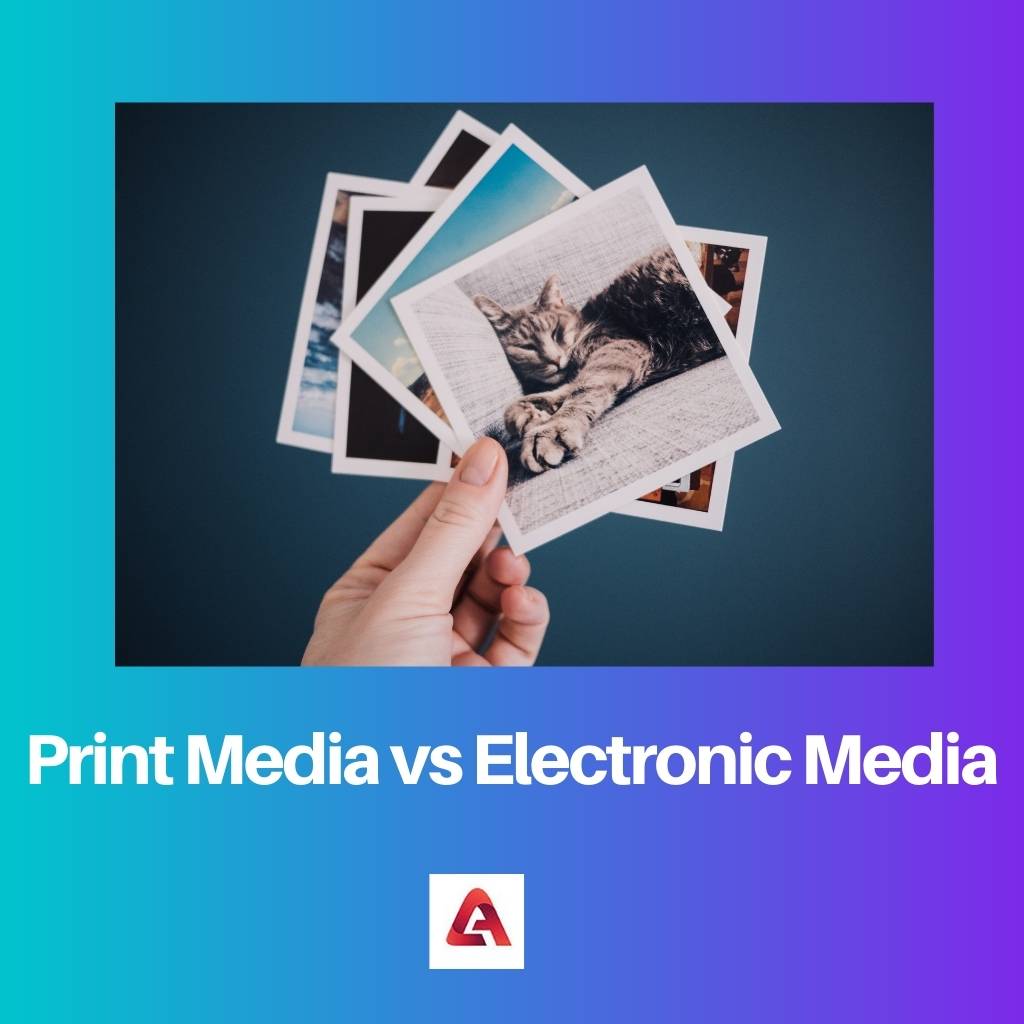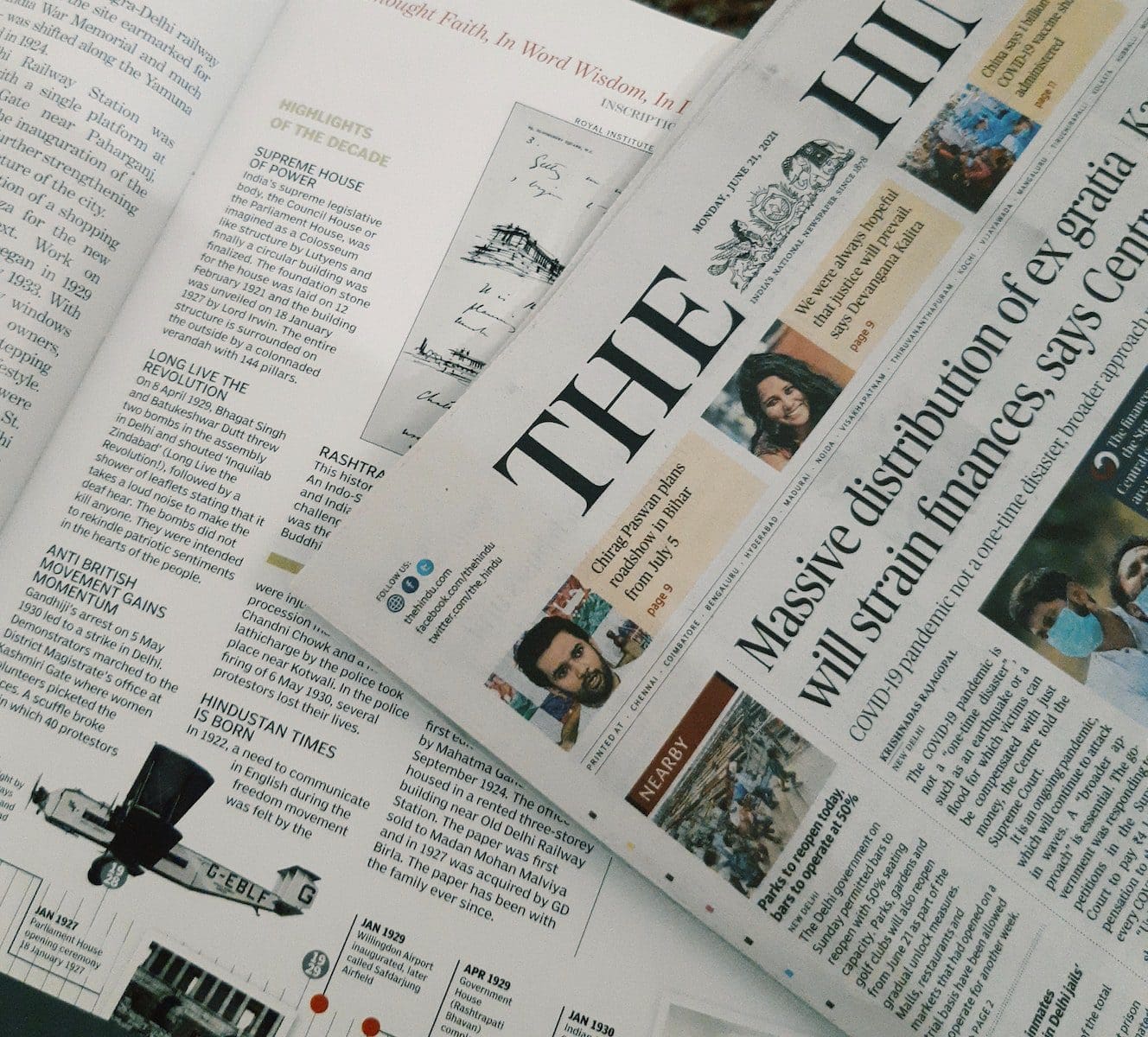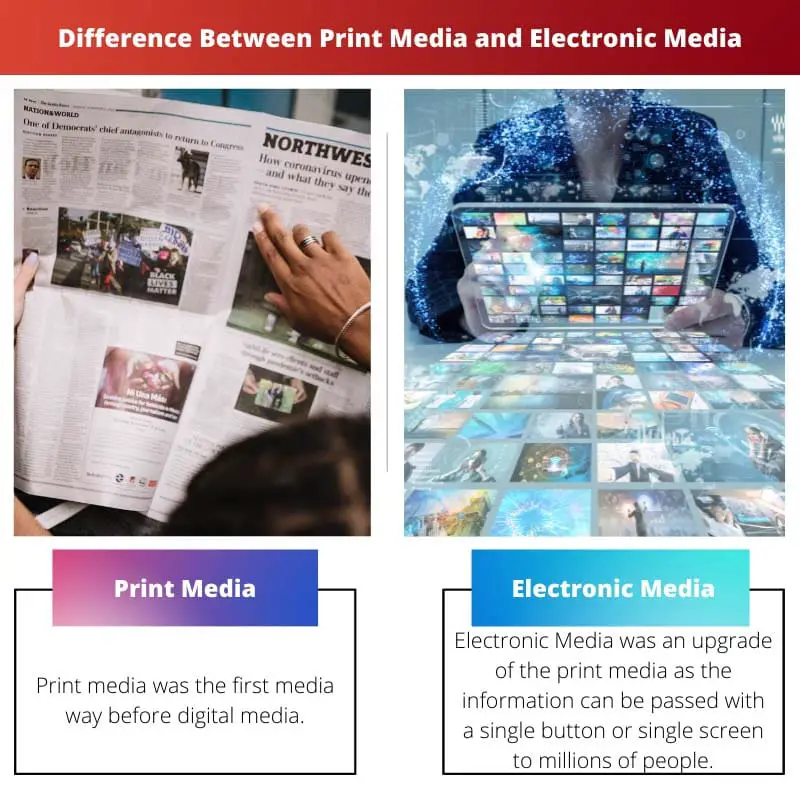Print media and Electronic media have been playing a big role in the whole world, ranging from history to the present democracy. The media shares news of the world with citizens and people around the world.
The people know about every corner of the world. The information can be spread in less than a minute.
Key Takeaways
- Print media refers to traditional media like newspapers and magazines, while electronic media refers to digital media like websites and social media.
- Print media has a longer production process compared to electronic media.
- Electronic media has a wider audience reach compared to print media.
Print Media vs Electronic Media
The difference between Print Media and Electronic Media is Print Media is not the latest technology and keeps on growing but the Electronic media uses the latest technology and keeps on growing the way of transferring news or any information to the world. Electronic media can be edited at any time, but Print media cannot be edited once published.

Print Media is the oldest technology. It has proof from history that there were local newspapers that shared news door-to-door during the partition. The print media not only indicates newspapers but the magazines, pamphlets, and wedding cards. Print Media does not use any device or the latest gadgets.
Electronic Media is the new way of passing information from one person to millions of people in a fraction of a second.
It even developed more when digitalization started in the whole world. Digitalization started with phones and computers, and now they are touch screen gadgets and many more applications which have made our daily lives so easy and faster.
Comparison Table
| Parameters Of Comparison | Print Media | Electronic Media |
|---|---|---|
| Technology | Old | New |
| Edited | No | Yes |
| Pace | Slow | Fast |
| Availability | Less | More |
| Forms | Newspapers, books, magazines | Radio, Television, Mobile |
| Send | Certain extent | Everywhere |
What is Print Media?
Print media was the first media way before digital media. Print media was also a powerful weapon and a medium to spread awareness during early British rule. It has various forms through which the print media works and spreads the information to a wide range of people.
It is called Print Media because the information is printed on paper using different inks. There are many forms of Print Media like newspapers, pamphlets, magazines, and books.
The technology is such that one person will type using the typewriter, and on the other end, the material gets printed on paper.
Then the technology kept developing due to which, later on, pictures could be printed, and then color technology helped the print media to make their printed materials more lively.
The newspaper is the oldest medium of printing information on pages and is still in use. Newspaper reading has a lot more benefits like it can increase your vocabulary and reading skills.
Advertisement and article writing is taught in schools in which newspaper is the best example of how such writing skills are done by the person.
Then magazines came in as a new way of printing exciting advertisements which even included private advertisements of residential parks and malls and many more.

What is Electronic Media?
Electronic Media was an upgrade of print media as the information can be passed with a single button or single screen to millions of people in a fraction of a second. It not only mesmerised people who were using it but also the public or the audience who were listening to it and watching it.
The radios were the first gadgets through which the public could hear the daily commentary of news and matches from another nation. The person can be in any other state or country, and still, with the use of electronic media, the public can hear it in any corner of the world.
The invention of television became a style at every home as the screen showed films and news. There were channels of every language. In the olden times, this marked a prestigious mark on the family.
Television became very interesting as the pictures were initially black and white, but this increased jobs for the people who wanted to become actors.
Technology did increase the job seats as technology has to be operated by the people only then can it be used in a good way. Technology never snatched jobs rather it gave jobs to people to earn for their livelihood. Technology was a change and marked development in society.

Main Differences Between Print Media and Electronic Media
- Print Media is not a new technology as compared to Electronic Media.
- Print Media cannot be edited, but Electronic Media can be edited.
- Print Media is slower than Electronic Media.
- Print Media cannot be found every time, but Electronic Media can be found at any time.
- Print Media is newspapers, magazines, and books, but Electronic Media is radio, television, and the internet.
- Print Media can be done to a certain extent, but Electronic Media can be sent around the world.


The insights into the historical background of print media and the innovative strides of electronic media demonstrate the enduring significance of media in shaping our global connectedness.
The comparison of parameters between print media and electronic media provides a clear distinction, allowing readers to appreciate the technological advancements that have shaped media dissemination.
The article provides a well-structured analysis of print and electronic media, emphasizing their technological differences and the implications of their availability for the global audience.
The article’s coverage of the emergence of electronic media and its impact on society emphasizes the constructive effects of technology on communication and cultural development.
This article provides a comprehensive comparison between print and electronic media and highlights the importance of media in sharing news worldwide.
The comparison table is particularly helpful in summarizing the key differences between print and electronic media. It’s fascinating to see how technology has shaped the dissemination of information.
I agree! The article dives into the history and development of both forms of media, providing valuable insights into their workflows and technologies.
The discussion of print media’s historical significance, from local newspapers to magazines, offers a rich understanding of its enduring impact on information distribution.
The detailed explanation of the forms and technological aspects of print media and electronic media enhances our understanding of how these mediums function and adapt to societal changes.
The article effectively distinguishes between print media and electronic media, shedding light on their roles in society and how they have evolved over time.
Absolutely! The examples provided, such as the early British rule and the development of television, help illustrate the profound impact of media on communication and culture.
The historical context of print and electronic media presented in the article is enlightening. It’s interesting to see how these forms of media have developed alongside societal changes.
The evolution of electronic media, from radios to television, reflects a profound shift in the way information reaches people. This article beautifully captures this transformative journey.